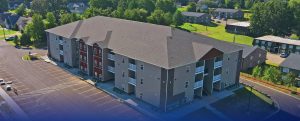A Home Without High Interest
Looking to 2023, the commercial real estate market is more ambiguous than ever, facing rising interest rates, cautious investors, and a difficult lending environment. Multifamily investment exploded in 2021, with the global pandemic encouraging migration across the nation, specifically to the Southeast, and development struggling to keep up with demand. 2022 saw a slight regression in the sector as consumers began to settle and rent rates became drastically high for many renters, and homeownership seemed to be a better long-term option for renting. Now, the 30-year fixed mortgage rate sits above seven percent, the highest rate in 20 years, which is pushing consumers back to renting. As “would-be” homeowners look for an alternative, single-family rentals (SFRs) and build-to-rent (BTR) communities are gaining popularity, as they offer the feeling of home without the inflated mortgage payments.
Market Rent Fundamentals
Multifamily rent growth is stabilizing after two years of historical increases, dropping to seven percent year-over-year in November 2022 compared to 22 percent, the national average between January 2021 and October 2022, according to Yardi Matrix. The SFR market’s rent growth increased 5.9 percent in November 2022, and occupancy remains strong at 95.9 percent. Compared to pre-pandemic levels, BTR and SFR rent rates are five times higher, according to CoreLogic.
Major metros continue to see high percentage growth above the national average as home price values skyrocket and loans become less accessible. Per Yardi Matrix, the national average rent price for the market is $2,091.
Driving Development
First-time home buyers are being priced out of acquiring a home or struggling to qualify for a mortgage in the current interest rate environment. This is driving the development and acquisition of these SFRs and BTR communities. As a tenant, an SFR and BTR home offers the spacious living space of a traditional home, along with the amenities and professional management services often seen in an apartment complex and without the need for a large down payment. The tenant can experience “home ownership” but doesn’t have to own the residence.
As banks continue to tighten their lending policies and home prices rise, build-to-rent communities will increase in demand. Current renters will be forced to wait until mortgage rates drop or home prices fall, unable to afford both expenses. Markets with a large population of renters are seeing spikes in SFR and BTR community developments as “renters by necessity” seek different options, and investors take notice. Multi-Housing News predicted in 2023, multifamily, senior living, and student housing developers will take on a large portion of the construction pipeline, which national homebuilding companies have historically dominated. For example, TruAmerica Multifamily, a California-based investment firm, launched a BFR division with plans to develop 1,600 lots.
Institutional Investment
In a high-interest rate environment, private investors and/or family offices have a harder time securing financing which then translates into more institutional acquisitions as competition lessens, especially in high-price-point markets such as multifamily.
With REITs’ ability to qualify and source cheap debt relative to the mom-and-pop investor at a local bank, they are driving the market for this type of unique product to become increasingly more popular. According to GlobeSt., institutional investors, although active in the SFR and BTR market, are more selective than in previous quarters. Capital is more focused on finding proven investors, developers, and so on, not willing to take a risk on smaller investors during a time of high inflation and interest.
“This is a change from six months ago when institutional capital was looking for any partner in the BTR/SFR space. Now they’re looking for bigger groups/more experienced sponsors who have been around at least one real estate cycle.”- GlobeSt.
What Does the Future Hold?
Although the SFR and BTR market is reporting strong fundamentals and is experiencing high demand in most major metros, investors will face challenges due to tightening capital. On the contrary, home ownership is not a viable option for the majority of Americans in the current economy, causing home sales to diminish and rental communities to increase in demand. Uncertainty is the name of the game going to the new year, but the one thing for sure is Millennials and Gen Zers are growing older, needing more space for an affordable price, and driving demand for SFR and BTR homes.









